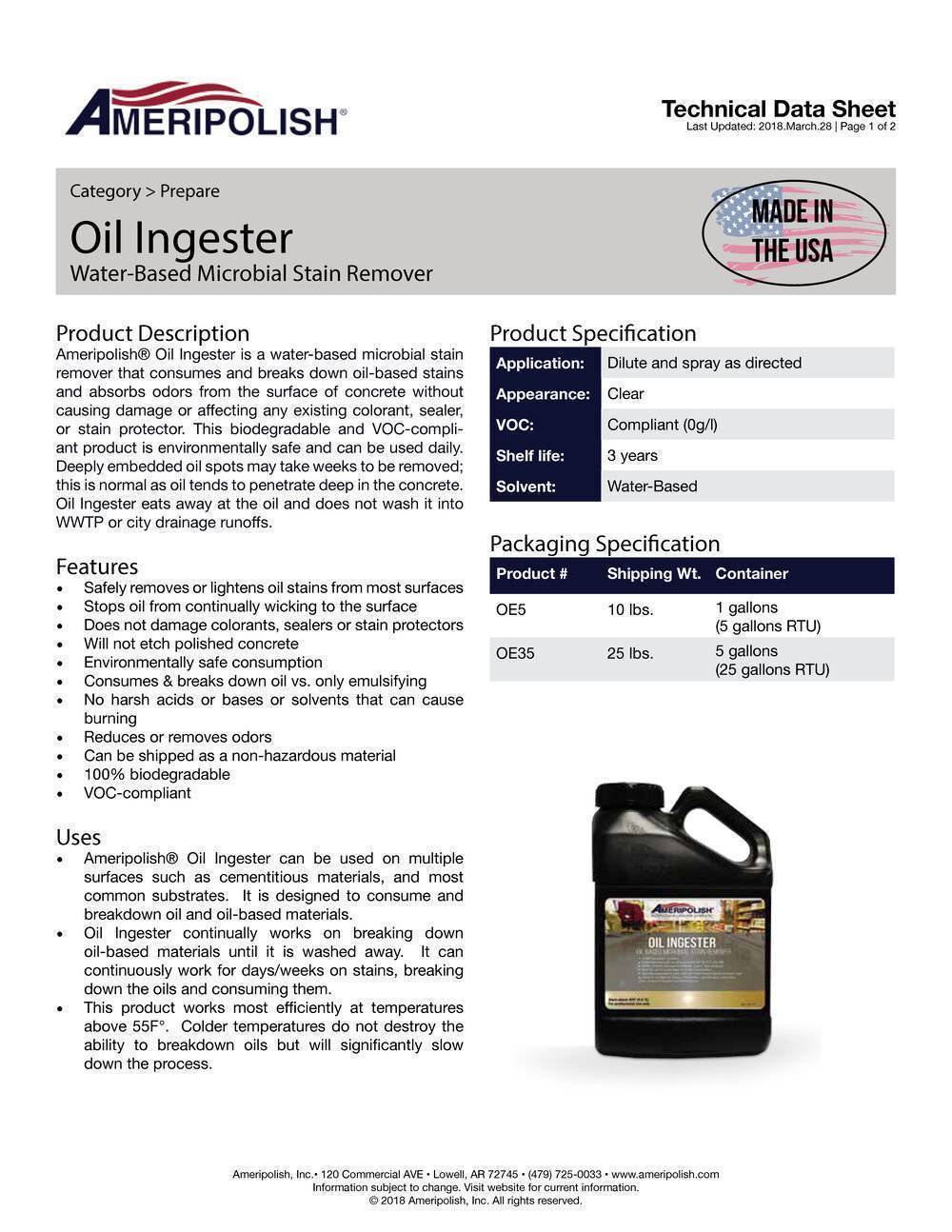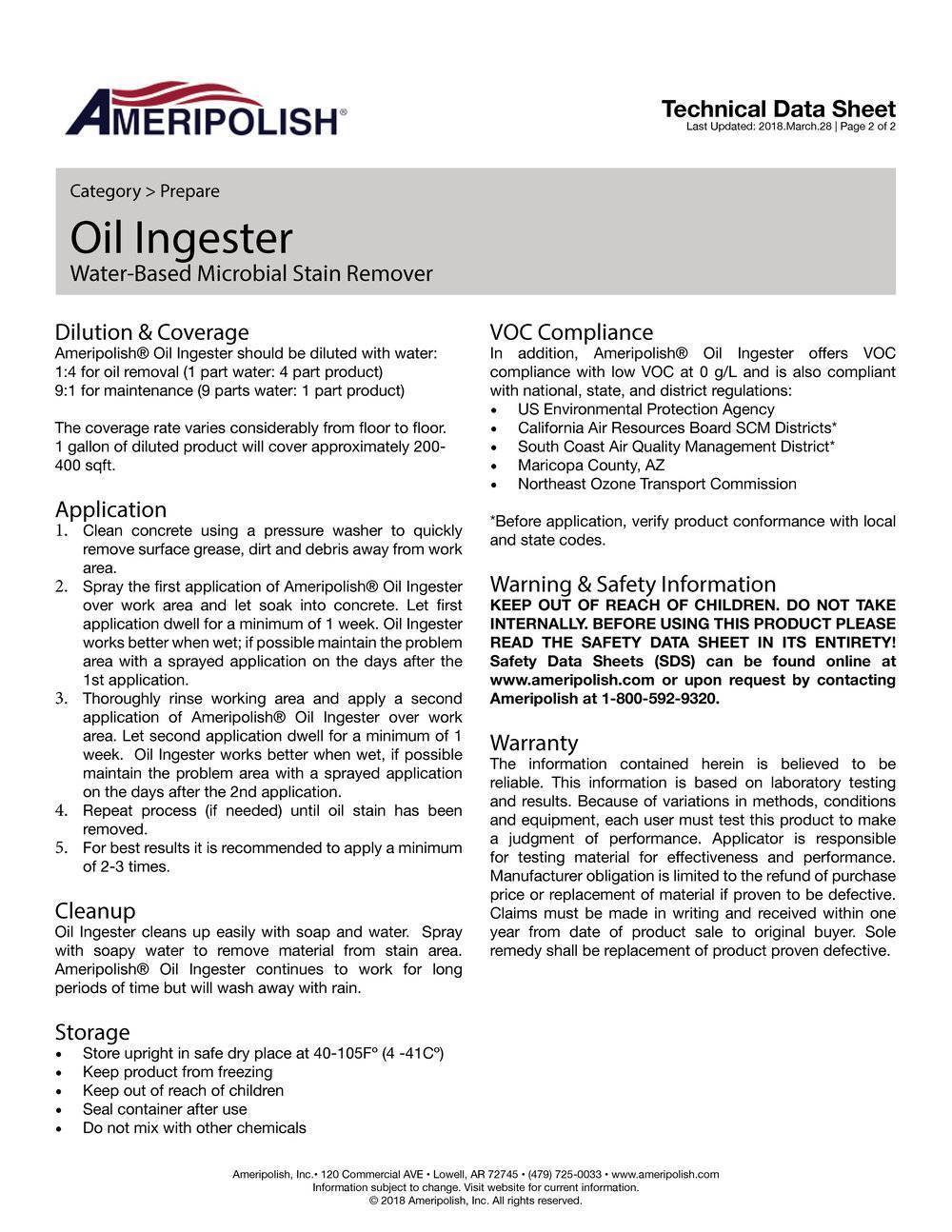Ameripolish Oil Stain Remover Data Sheet
Ameripolish® Oil Ingester is a water-based microbial stain remover that consumes and breaks down oil-based stains and absorbs odors from the surface of concrete, without causing damage or affecting any existing colorant, sealer, or stain protector.
This product is often used prior to concrete polishing on patios, garages, or any other areas that may have been stained by oil prior to concrete floor finishing.
Removing Oil Stains From Concrete Floors:
Microbial Oil Stain Removers
Microbial oil stain removal methods can be used on multiple surfaces (cementitious materials and most common substrates) and are a proven, environmentally-friendly way to consume and break down oil as well as most oil-based materials.
These removers work by utilizing single-cell, nonpathogenic microorganisms that survive and thrive on eating up crude oil, digesting it, and turning that oil into CO2. When the microorganism is done consuming the unsightly oil stain and the oil is no longer present, the microorganisms die only to leave your concrete floor cleaner than you could imagine.
Benefits of Microbial Oil Stain Removers
Safely removes or lightens oil stains from most surfaces
- Stops oil from continually wicking to the surface
- Does not damage colorants, sealers, or stain protectors
- Will not etch polished concrete
- Environmentally safe consumption
- Consumes and breaks down oil as opposed to only emulsifying
- No harsh acids or bases or solvents that can cause burning
- Reduces or removes odors completely
- Can be shipped as a non-hazardous material
- 100% biodegradable
- VOC-compliant
- Easy clean-up with the help of soap and water
The product mentioned above can work in both colder and warmer climates; however, the temperature with which the oil stain remover works most effectively is above 55 degrees Fahrenheit. While a 55 degree or lower temperature will still suffice and the breakdown of oil stains will still occur, the process might be significantly slower than initially anticipated.
DRAWBACKS OF MICROBIAL OIL STAIN REMOVERS
When looking to remove oil stains from your concrete driveway, garage floor, or even your home/ business, utilizing an eco-friendly product (that doesn’t have you hunting down heaps of cat litter or digging into your surplus of laundry detergent) can be an easy solution to gravitate towards. However, like any product on the market, there can be a drawback or two.
One of the drawbacks of using a microbial oil stain remover like Ameripolish Oil Ingester is that the process can be a bit on the slower side.
Why?
Due to the living microorganism that makes up the bulk of the product, daily water application is needed to keep the bacteria alive in order to consume the oil.
Another drawback is the price.
With a price point that boasts only $0.13 – $0.20 / sq foot, Ameripolish doesn’t necessarily stand out as a product that aims to break the bank. However, each container is sold starting at $82.50 for one gallon (capable of covering 400-600 sq. feet) and goes up to five gallons. This in and of itself indicates one gallon of microbial oil stain remover was designed to cover a LOT of square footage, usually an amount that is far greater than any typical need.
To this point, while purchasing microbial stain remover makes removing oil stains from your concrete a highly environmentally friendly choice, it also makes it a higher-priced alternative. An easy way to alleviate these costs while also choosing the eco-conscious option is to hire a company that regularly uses this product, like Crafstman Concrete.
Alternatives to Microbial Oil Stain Removers
If a VOC-compliant microbial product like Ameripolish Oil Ingester doesn’t align with your desired method to remove oil stains from your concrete surface, there are effective alternatives you can consider.
However, please keep in mind these alternatives for removing oil stains are more effective the newer the stain is. If by chance, the stain on your garage, driveway, or home floor is larger and/or older, the above microbial method might prove more effective.
REMOVE OIL STAINS WITH A POULTICE
A poultice is a term used to reference a paste-like substance created from the marriage of absorbent material, much like baking soda, laundry detergent, sawdust, or kitty litter, with a strong solvent such as acetone or paint thinner.
When created safely at home, the step-by-step instructions for using a poultice are as follows:
- Wipe away any excess oil from your oil stains. (Make sure you’re wearing rubber gloves).
- Create a thick layer of DIY poultice that can be smeared over your unsightly oil stains.
- Cover both the poultice and the oil stains with plastic.
- Tape down the edges of the plastic to your concrete floor and wait.
- Once your poultice has had time to sit overnight (no stiff brushes and vigorous scrubbing necessary) you can remove the plastic, wait for the remaining poultice to dry, and then wipe your concrete floor clean.
removE oil stains with a degreaser
Degreasers are products specifically designed to remove grease and other oil-based compounds from concrete surfaces.
There are multiple degreasers to choose from at your local hardware store. With that being said, please take note that not all degreasers on the market are environmentally-friendly or VOC-compliant.
The step-by-step instructions on using a degreaser are as follows:
- Wipe away any excess oil from your oil stains. (Make sure you’re wearing rubber gloves).
- Dilute your solution based on the severity of your oil stains. (A common ratio of degreaser to water is one part degreaser to four parts water for severe oil stains, and one part degreaser to up to 200 parts water for less aggressive oil stains.)
- Simply pour a generous amount of the diluted solution on any unsightly concrete surfaces using your choice between a cleaning bristle brush, mop, low-pressure sprayer, or even power washer.
- Let the solution sit on the oil stains for up to three minutes.
- Reapply the solution and begin scrubbing vigorously.
- Once the oil stains have lifted you can wash away the remaining solution with water to reveal a cleaner concrete driveway, garage floor, or home/ business.
While prevention is key, oil leaks and spills are a natural part of day-to-day life and they’re bound to happen to even the best concrete driveways and floors. But if you’re not in the mood to scrub baking soda or harsh chemicals on your concrete floors and you’d like the help of professionals with both tools and experience, Craftsman Concrete is just a call away.
Need to Remove a Stain Other Than Oil?
See our page about restoring polished concrete after stains or spills.
Looking for More Information About Polished Concrete?
See our polished concrete floors page for resources and galleries. As always, give us a call for a free consultation.



